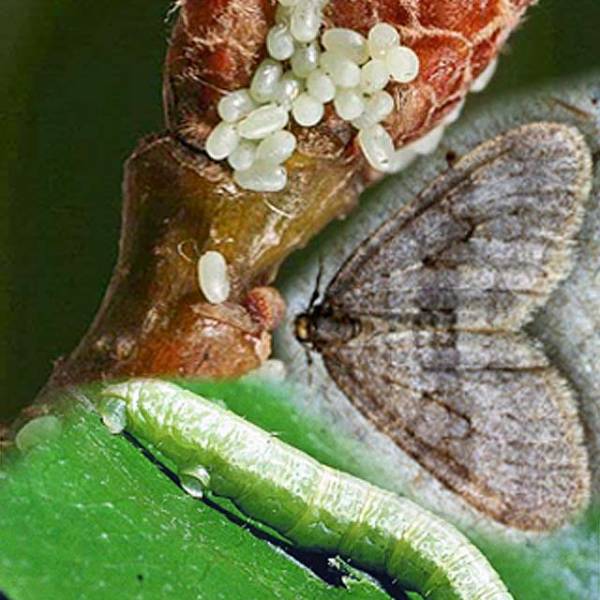
We get a lot of calls in mid to late May on the Horticulture Desk from homeowners and others a bit alarmed to see anything from lots of holes in their leaves to large trees that have been substantially defoliated but with no leaves dropping on the ground. The culprit in these cases is almost always the winter moth caterpillar.
By the end of May, winter moth caterpillar has nearly run its course in most of eastern Massachusetts. But as it can still do a lot of damage in a short time, it is worth treating your landscape for them if there are any caterpillars left.
By late May, the caterpillars are large enough that you should use a broader-band contact insecticide such as one of the pyrethrins or spinosad. I recommend a product we carry called Captain Jack’s Dead Bug Brew, from Bonide, based on spinosad as the active ingredient. Spinosad is extracted from a fermented organism and is considered bio-rational.
Like most contact insecticides it also affects the beneficial insects. You should spray Captain Jack’s on your susceptible plants in the early evening when bees are not foraging. When spinosad dries, its toxicity to bees drops dramatically, but its toxicity to the caterpillars remains high.
If any caterpillars remain a week after you spray, then treat again.
Winter moth caterpillars feed on a long list of deciduous broad-leaf foliage: maples, fruit trees (both fruiting and ornamental), oaks, beeches, birches, elms, ashes, mountain ashes, lindens, blueberries, roses, deciduous azaleas, and others. They infest and defoliate not so much individual as landscapes or portions of landscapes. If you have very large trees that show significant feeding activity, you might consider seeking quotations for treatment by a professional tree service company.
Next year, start looking for the first signs of winter moth caterpillar approximately at Patriot’s Day. They hatch in our area between the middle of April and the first week in May. The live, feeding on foliage, for about 4 to 6 weeks. Then they crawl into the soil to pupate, and are gone from our trees and shrubs by some time in early June. The moths emerge in late November. They are the moths that you see at your outdoor lights in the evening during December.
By early January they lay their eggs and are gone. Some people try to control the hatching by spraying with horticultural oil in late March or the first week in April. This can be difficult as the moths often lay eggs in crevices that are hard to penetrate. But partial success has benefits in limiting the population and the rate of early damage, but it does not usually eliminate the need to treat for caterpillars. When the caterpillars are young and small, they are effectively treated with a narrow-band insecticide based on the bacterium Bacillus thuringiensis (Kurstaki) or BtK, another bio-rational insecticide. BtK targets only lepidopteran caterpillars, and is highly effective when the winter moth caterpillar is up to about 3/8 to 1/2 inch in length. The effectiveness of BtK drops for older, larger caterpillars. The product that we carry based on BtK is Bonide’s Thuricide.









